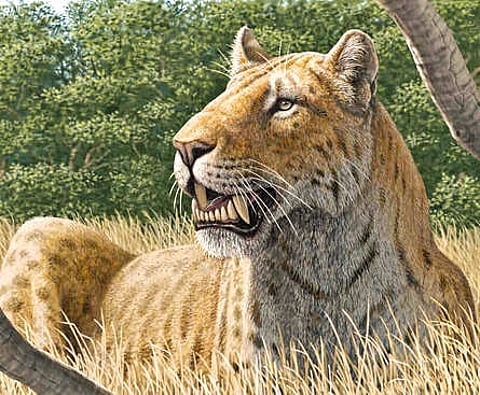

By: ANTHONY HAM
Close your eyes and picture being face-to-face with a saber-toothed cat. Most likely you’ll see in your frightened mind’s eye the long, curved upper canines — particularly sinister because those dagger-shaped teeth remained in full view, even when the cat closed its mouth. What appears in your imagination may be incorrect, at least for a species of saber-toothed cat that was one of the most widespread in Earth’s ancient history. In a study, a team of researchers argues that many artistic reconstructions of Homotherium latidens are wrong. Depictions of the cats with pointy teeth at the ready need to be revised, because the animal’s defining feature was a concealed weapon until the cat was ready to strike or otherwise opened its mouth.
Homotherium latidens was “the most powerful saber-tooth cat of the Old-World Pleistocene,” Mauricio Anton, a paleontological artist, expert on saber-toothed cats and one of the study’s authors, said. According to the fossil record, Homotherium first appeared around four million years ago, during the Pliocene. The species ranged from the southernmost tip of Africa, across Eurasia and into South America. A fossil site in Friesenhahn Cave in Texas suggested groups of Homotheriums may have hunted cooperatively to bring down mammoths. The species fell extinct 10,000 years ago.
The cat was the size of a lion, weighed up to 550 pounds, and had long, scimitar-shaped, serrated upper canines. In a paper Anton wrote in 2009, he concluded, “The tips of the sabers of Homotherium would have been visible in life, protruding beyond the lips,” even when the cat was at rest. Homotherium fit the stereotypical profile of the saber-toothed cat. But more recently, Anton began to wonder if he and other paleontological researchers were getting the cat’s deadly dentition wrong.
For decades, almost everything that scientists knew about saber-toothed cats came from fossils and dissections of modern big cats. “When you dissect a dead big cat, the lips are in particular position because the muscles that control the lips are relaxed,” Anton said. “That was where our data came from.”
Then in 2016, while watching a film he had made of a magnificent, yawning male lion in the Okavango Delta, Anton noticed something he had never seen before: “The lower lip was contracting as the mouth was closing, and before full closure, it was enveloping the tip of the canine. I was like, ‘Am I really seeing this?’ It was a Eureka moment.” To understand the implications of his observation, Anton and a team of scientists studied living big cats in minute detail. They looked at fossil dissections with what Anton described as “new eyes.” And they made a 3-D CT scan of an intact, 3 mn-year-old fossil of a Homotherium latidens that had been excavated in Perrier, France.
Their studies confirmed that there simply wasn’t room for the lower lip and soft tissue to fit between Homotherium’s upper canine and the gum. But there was room for the canines to be hidden against the enclosed part of the lower mandible or jaw. Whatever their aesthetics, saber-toothed cats remained frightening predators. Unlike modern big cats such as lions and tigers, the narrow, blade-like teeth of Homotherium were “precision weapons,” said Anton. “Once the sabers cut the arteries of the neck,” he added, “the animal lost blood very quickly and would pass out in seconds.” This could be just the start. “We have a whole biosphere in museum drawers waiting to be discovered.”
Visit news.dtnext.in to explore our interactive epaper!
Download the DT Next app for more exciting features!
Click here for iOS
Click here for Android